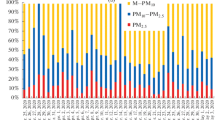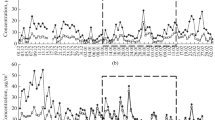Abstract
The measurements of soot aerosol concentration in Moscow and Beijing in 2004–2010 are presented. The variability ranges of one-time soot concentrations in this period of time had been 0.1–77 μg/m3 in Beijing and 0.1–22 μg/m3 in Moscow. The seven-year average daytime soot concentration in Beijing is 2.5 times higher than in Moscow. The seasonal behavior of the soot concentration is more pronounced in Moscow: the soot concentration is 33% lower in summer than in winter, and only 13% lower in Beijing. Analysis of back trajectories of air mass transport and variations in soot concentration showed that the soot content in the atmosphere of Beijing significantly increases when air masses are transported from industrially developed regions south of Beijing. The air pollution by soot in Moscow predominantly decreases due to advection when air masses from northern regions come to Moscow.



Similar content being viewed by others
REFERENCES
G. S. Golitsyn, E. I. Grechko, Van, Genchen, Van, Pusai, A. V. Dzhola, A. S. Emilenko, V. M. Kopeikin, V. S. , A. N. Safronov, and E. V. Fokeeva, “ Studying the pollution of Moscow and Beijing atmospheres with carbon monoxide and aerosol,” Izv., Atmos. Ocean. Phys. 51 (1), 1–11 (2015).
G. V. Rozenberg, About the nature of aerosol absorption in the shortwave spectral region,” Izv. Acad. Nauk. SSSR. Fiz. Atmos. Okeana. 15 (12), 1280–1291 (1979).
V. A. Petrukhin, Risk of Population Disease Due to the Air Pollution by Vehicles, Experience of Applications of Techniques for Risk Assessment in Russia (Nauka, Moscow, 2000) [in Russian].
R. L. Dod, R. D. Giauque, and T. Novakov, “Sulfate and carbonaceous aerosols in Bejing, China,” Atmos. Environ. 20 (11), 2271–2275 (1986).
K. He, F. Yang, Y. Ma, Q. Zhang, X. Yao, C. K. Chan, S. Cadle, T. Chan, and P. Mulawa, “The characteristics of PM2.5 in Beijing, China,” Atmos. Environ. 35 (29), 4959–4970 (2001).
A. S. Emilenko and V. M. Kopeikin, “Comparison of synchronous measurements of soot and submicron aerosol concentrations in regions with different anthropogenic loadings,” Atmos. Ocean. Opt. 22 (4), 421–427 (2009).
R. J. Zhang, J. J. Cao, S. C. Lee, Z. X. Shen, and K. F. Ho, “Carbonaceous aerosols in PM10 and pollution gases in winter in Beijing,” Environ. Sci. China. 19 (5), 564–571 (2007).
F. Yang, L. Huang, F. Duan, W. Zhang, K. He, Y. Ma, J. R. Brook, J. Tan, Q. Zhao, and Y. Cheng, “Carbonaceous species in PM2.5 at a pair of rural-urban sites in Beijing, 2005–2008,” Atmos. Chem. Phys. Discuss. 11, 8719–8746 (2011).
G. C. Wang, J. Bai, Q. Kong, and A. Emilenko, “Black carbon particles in the atmosphere in Beijing,” Adv. Atmos. Sci. 22 (5), 640–646 (2005).
Reference Book on Environmental-Climate Characteristics, Ed. by A.A. Isaev (MSU, Moscow, 2005), vol. 2 [in Russian].
Yu. S. Osipov, L. P. Gorelova, and V. I. Chernyaeva, “Monitoring of the environmental pollution in Moscow,” in Meteorology and Climatology in USSR (Moscow Branch of the Geographical Society of USSR, 1991) [in Russian].
V. M. Kopeikin, Candidate’s Dissertation in Mathematics and Physics (Moscow, 1998).
R. J. Zhang, J. J. Cao, S. C. Lee, Z. X. Shen, and K. F. Ho, “Carbonaceous aerosols in PM10 and pollution gases in winter in Beijing,” Environ. Sci. 19 (5), 564–571 (2007).
X. He, C. C. Li, A. K. H. Lau, Z. Z. Deng, J. T. Mao, M. H. Wang, and X. Y. Liu, “An intensive study of aerosol optical properties in Beijing urban area,” Atmos. Chem. Phys. 9, 8903–8915 (2009).
A. S. Emilenko, Wang Gengchen, M. A. Sviridenkov, A. A. Isakov, and V. M. Kopeikin, “Comparison of the levels of soot and submicron aerosol pollution near surface in conditions of Beijing and Moscow,” in Intern. Sympos. on Atmos. Phys. and Chem. Qufu, Shandong, China, 2007. P. 5–8.
Funding
This work was supported in part by the Russian Foundation for Basic Research (project no. 18-55-53 062).
Author information
Authors and Affiliations
Corresponding authors
Ethics declarations
The authors declare that they have no conflicts of interest.
Additional information
Translated by O. Bazhenov
Rights and permissions
About this article
Cite this article
Kopeikin, V.M., Golitsyn, G.S., Gengchen, W. et al. Variations in Soot Concentrations in the Megalopolises of Beijing and Moscow. Atmos Ocean Opt 32, 540–544 (2019). https://doi.org/10.1134/S1024856019050099
Received:
Revised:
Accepted:
Published:
Issue Date:
DOI: https://doi.org/10.1134/S1024856019050099




